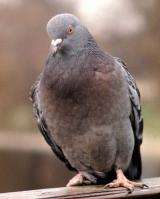November 29, 2011 report
Study finds pigeons use bodies to turn rather than wing force

(PhysOrg.com) -- In a rather surprising turn of events, it appears pigeons use their body to make sharp turns, rather than stronger wing strokes when flying. This bit of news comes from Ivo Ros of Harvard University and his colleagues who have been studying the bird’s flight skills with high speed cameras. They have published their results in the Proceedings of the National Academy of Sciences.
Intuitively, it might seem, at least to humans who have no natural wings of course, that to turn, especially when sharp angles are involved, that flailing the wing harder or faster that is opposite the turn would be the most natural way to proceed. After all, that’s the approach us humans would use in water for instance, in trying to turn quickly. But that’s not how birds operate, at least not pigeons. Ros and his team set up nine high-speed synchronized cameras in a hall that had a ninety degree turn in the middle of it. They then marked a pigeon in sixteen places to track just exactly how each body part moved as it flew. They then set the bird to flying the hallway, capturing every detail and noting precisely what goes on with its body, wings, and tail as it turns. Surprisingly, it turned out that the pigeon neither flapped faster or harder, opting instead to simply turn or roll its body to adjust for the turn and allowing its wings to flap as they would were the bird heading straight. Once through the turn, the bird then readjusted its body to enable straight ahead flight.
While all this may not seem all that remarkable, after all, the pigeons have likely been turning in flight for more years than we have held interest in how they do so, the observations may provide important information for people wishing to improve on clunky old human flight, or more specifically, when trying to build drones that can fly better than what is available today.
It’s not hard to imagine the difference. Sending a drone down a narrow hall where it must negotiate a ninety degree turn is quite frankly, impossible at this point, though a helicopter, which perhaps not coincidently turns in ways very similar to the pigeon, could do it with ease. This is because it can slow down without losing lift. But if the drone could be made to maneuver its body as it turns, perhaps then it could perform maneuvers that the common pigeon takes for granted.
More information: Pigeons steer like helicopters and generate down- and upstroke lift during low speed turns, PNAS, Published online before print November 28, 2011, doi: 10.1073/pnas.1107519108
Abstract
Turning is crucial for animals, particularly during predator–prey interactions and to avoid obstacles. For flying animals, turning consists of changes in (i) flight trajectory, or path of travel, and (ii) body orientation, or 3D angular position. Changes in flight trajectory can only be achieved by modulating aerodynamic forces relative to gravity. How birds coordinate aerodynamic force production relative to changes in body orientation during turns is key to understanding the control strategies used in avian maneuvering flight. We hypothesized that pigeons produce aerodynamic forces in a uniform direction relative to their bodies, requiring changes in body orientation to redirect those forces to turn. Using detailed 3D kinematics and body mass distributions, we examined net aerodynamic forces and body orientations in slowly flying pigeons (Columba livia) executing level 90° turns. The net aerodynamic force averaged over the downstroke was maintained in a fixed direction relative to the body throughout the turn, even though the body orientation of the birds varied substantially. Early in the turn, changes in body orientation primarily redirected the downstroke aerodynamic force, affecting the bird’s flight trajectory. Subsequently, the pigeon mainly reacquired the body orientation used in forward flight without affecting its flight trajectory. Surprisingly, the pigeon’s upstroke generated aerodynamic forces that were approximately 50% of those generated during the downstroke, nearly matching the relative upstroke forces produced by hummingbirds. Thus, pigeons achieve low speed turns much like helicopters, by using whole-body rotations to alter the direction of aerodynamic force production to change their flight trajectory.
Journal information: Proceedings of the National Academy of Sciences
© 2011 PhysOrg.com
















